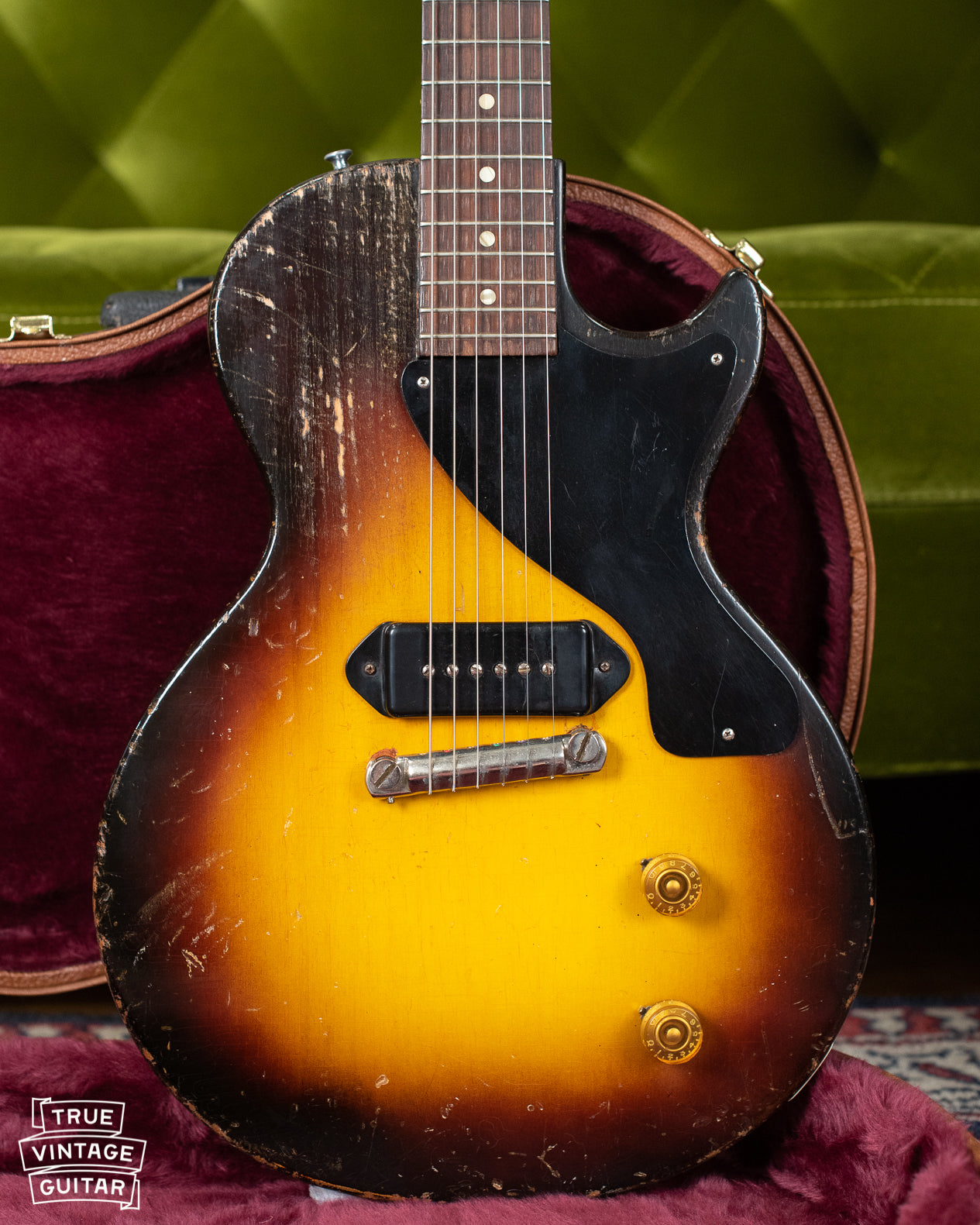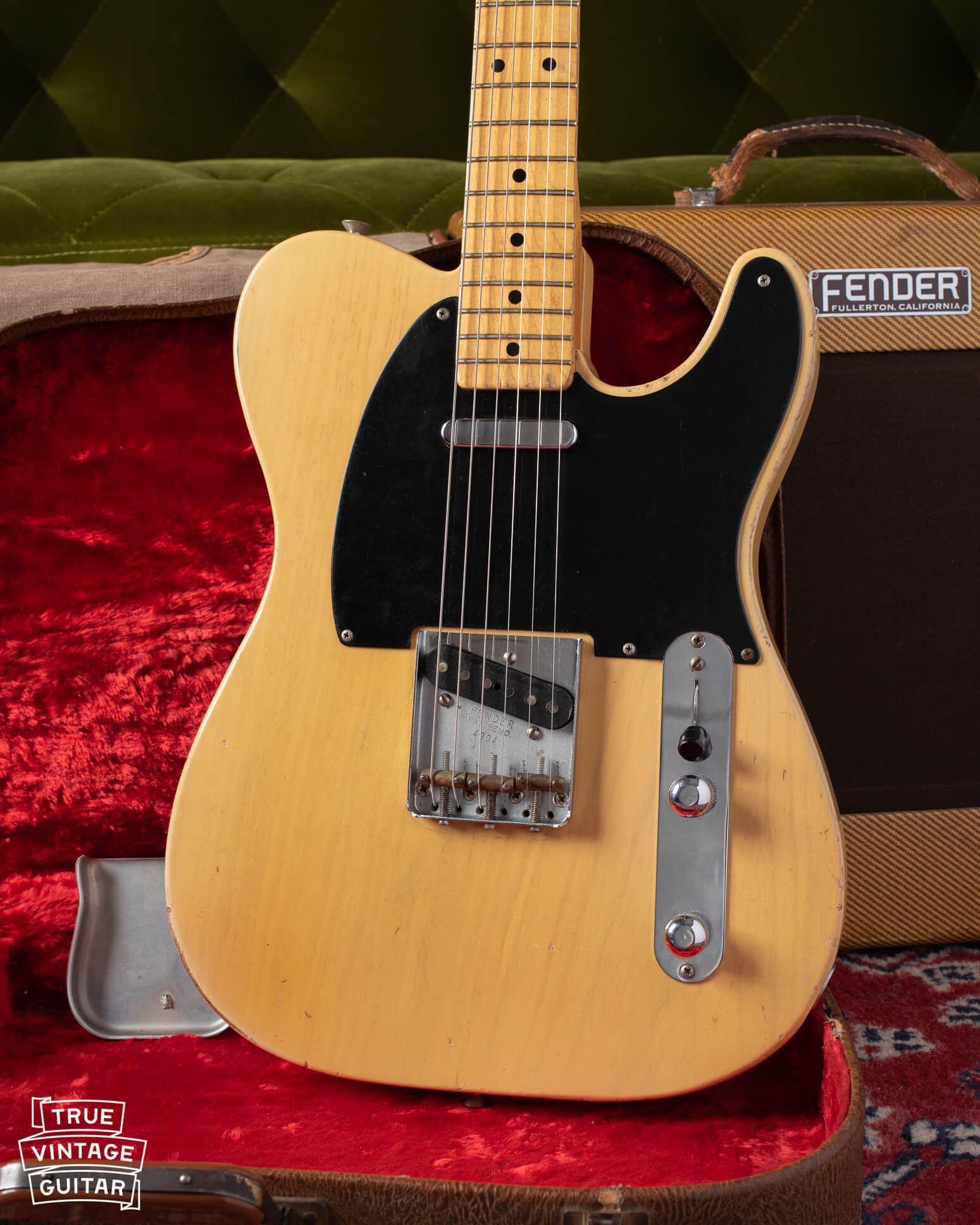It's important to gather all the data possible before doing a vintage guitar valuation, especially with vintage Gibson Les Paul guitars. Many vintage guitar dealers have great photos on their websites but often don't post the most important pictures to help determine the condition and originality of the guitar. I'd like for this website to be a resource for that information for not only this 1954 Gibson Les Paul goldtop but also to compare to other vintage Gibson Les Paul guitars. It's fun to compare and contrast all the intricacies of manufacturing and aging. Here are a couple of important pictures of this vintage 1954 Gibson Les Paul goldtop.
I am a passion vintage Gibson guitar collector and am always looking for nice examples of 1950s Gibson Les Paul guitars. You can contact me here to sell a vintage Gibson Les Paul guitar.

This is a profile view of the original P-90 pickup bobbins and coils on the '54 Gibson Les Paul goldtop. You can see the factory black tape that Gibson wrapped around the original coils that's undisturbed as well as two black wires coming out from the bottom of the coil. P-90 pickups from the 1960s will have one black wire and one white wire helping to signal which lead is the hot and which is the ground wire.

Here's a shot of the base plate of the vintage 1954 Gibson P-90 pickup in the neck position. Everything looks kosher here including the kind of crude looking masking tape covering the connection of the hot wire from the coil to the shielded lead. This picture also shows an interesting feature to this guitar which is that has three strand shielding wire on the leads. This is a far less common shielded wire but does seem to show up in guitars from 1952-1955 or so. A PAF humbucking pickup from the late 1950s should have two strand shielding instead of three strand shielded wire but three strand is common enough on early 1950s Les Paul guitars.

This is the neck pickup cavity of the 1954 Gibson Les Paul Model goldtop showing the gold finish and the long neck tenon. Gibson didn't need to tape of the neck pickup cavity while finishing the top in gold so a proper cavity should have mostly undisturbed gold finish inside. The neck tenon, or part of the Mahogany neck that is glued into the body, is visible in this pocket. The gold finish over the joint of the tenon should be undisturbed if the neck is original to the guitar and it hasn't had a neck reset.

This is the back of the vintage 1954 Gibson Les Paul Model goldtop with the control plate removed showing the control cavity. The original volume and tone potentiometers are visible along with the Grey Tiger capacitors. We can also see the other end of the three strand shielded lead wire with green and yellow cloth leads inside. This pictures shows one bit of touched up solder on the wire connecting the Grey Tiger capacitor to the neck pickup volume pot. This capacitor was disconnected and left in place when I acquired the guitar from the grandson of the original owner. I believe it was disconnected because the tone potentiometer was mostly stuck in a low position. I was easily able to clean the potentiometer and now it's in excellent functioning condition just like the others. I reconnected the capacitor to the circuit.

Lastly, this is a profile view of the wrap tail bridge on the vintage 1954 Gibson Les Paul Model goldtop. I've included this picture to show the height of the bridge off the top as well as the degree of lean to the bridge posts. Many players request this view in order to determine the neck pitch and post lean. The neck is glued in on vintage Gibson Les Paul guitars so it can be very expensive to change the neck pitch although it's not necessary on vintage Gibson Les Paul guitars from 1954. However, vintage Gibson Les Pauls from 1953-1955 can sometimes suffer from post lean. This refers to bridge posts that adjust the height of the bridge up and down. The posts and bushings on Gibson Les Paul guitars from this time period are shorter than posts and bushings used after 1956. Gibson deepened the amount of post set in the body in order to gain leverage so that the post wouldn't begin to lean under constant string tension.
I hope you enjoyed this look at the important parts of a vintage Gibson Les Paul goldtop guitar! I'm always looking to buy nice example of vintage Gibson guitars but I especially love anything that says "Les Paul" on the neck. You can reach out to me and possibly sell your vintage guitar to me here: https://truevintageguitar.com/pages/sell-vintage-gibson-guitar



